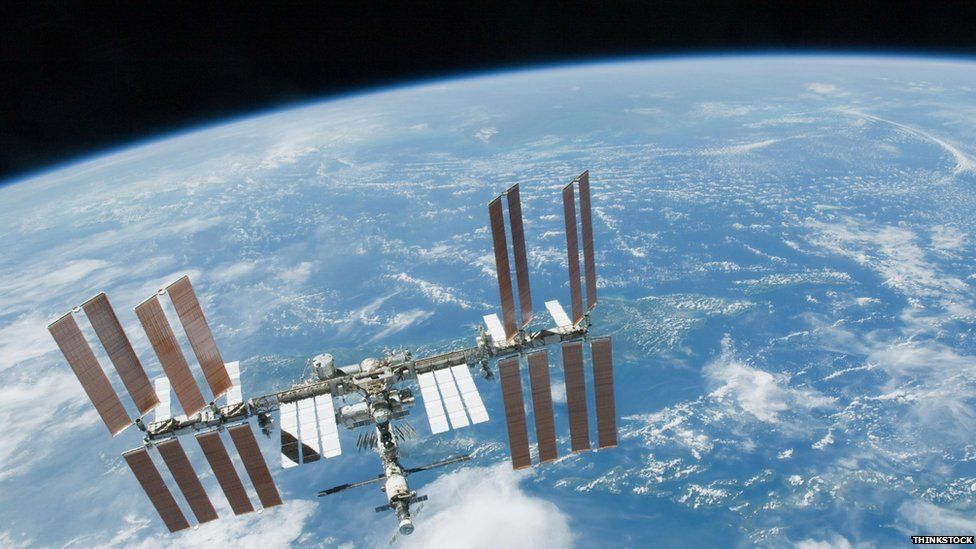People have been on board the International Space Station constantly for 15 years
- Published

People have been living in space on board the International Space Station (ISS) for 15 years.
The giant floating laboratory has been travelling at five miles per second since the first part of it was launched into orbit in 1998.
The first crew, Expedition One, arrived on 2 November 2000 and someone has been on board ever since.
The ISS is the size of a football pitch and orbits Earth every ninety minutes
A good excuse then to celebrate the symbol of what humans down here on earth can do, when we work together.
The International Space Station is an international project involving the US, Russia, Canada, Europe and Japan.
According to Nasa, external it is the size of an American Football field (which is slightly bigger than a football - or soccer - pitch).
The bit where crews live and work is around the size of a Boeing 747 plane.
The International Space Station orbits the earth 15.54 times a day. It's the second biggest object in the night sky after the moon.
The ISS is powered by solar panels
The first mission lasted almost five months. The latest mission (Expedition 45) will have lasted more than three months when the crew returns to earth on 22 December.
Since 2000, 220 people from 17 countries have visited the ISS. The first crew was made up of three astronauts from America, Russia and Ukraine.
At the moment six people are living on board, and despite taking the odd break to play with floating oranges (below) the work of an astronaut can be complicated.
The crew of Expedition 1 in 2000, Yuri Gidzenko, Cmdr William Shepherd and Sergei Krikalev
Nasa says Expedition 45's tasks include conducting experiments "that help researchers study dark matter and cosmic rays, investigating the interactions of flames on the motion and ignition of droplets and assessing the effects of spaceflight on chromosomal telomeres." *head scratch*
This photo shows materials being tested in space.
The samples are attached to the outside of the ISS to see what effects direct sunlight, ultraviolet rays, extreme heat and radiation have on certain materials. It can help them design spacecrafts in future.
Materials exposed to the effects of outer space
Biology research on the ISS is credited with helping develop treatments from conditions on earth like muscular dystrophy.
This is German astronaut Alexander Gerst inside the ISS
The ISS could play an important role in any future missions to Mars as a "springboard", says Nasa.
But it can also look closely back to earth. Here you can see details of streets and parks in Paris, including the Eiffel Tower (circled).
The Eiffel Tower as seen from the ISS
You can sometimes spot the ISS from earth.
On Christmas Eve 2014 its path (circled) was spotted above London.
It's not as lonely as it once was flying through space. Astronauts can make video calls to their families.
President Obama even made contact a few years back. He wanted to congratulate the crew for successfully adding a new observation dome on the space station.
Do you remember what you were doing on 28 February 2011? Nasa astronauts Steve Bowen and Alvin Drew probably do. They were strapped to the outside of the ISS for more than six hours.
It was a planned spacewalk to carry out maintenance. Russian and American astronauts have carried out 118 spacewalks since 2000.
NASA astronauts Steve Bowen and Alvin Drew on a spacewalk.
Steve Bowen and Alvin Drew literally in outer space
In this picture you can see the Southern Lights (Aurora Australis) dramatically skimming across the surface of the globe.
But also notice the wing of the Nasa space shuttle Atlantis in the foreground. It had popped up from earth on a 12-day mission to drop off supplies.
Atlantis docked with the ISS and the southern lights
The emblem and crew of Expedition 45, currently manning the International Space Centre
Last month Nasa released thousands of photographs from the Apollo missions.
Follow @BBCNewsbeat, external on Twitter, BBCNewsbeat, external on Instagram, Radio1Newsbeat, external on YouTube and you can now follow BBC_Newsbeat on Snapchat